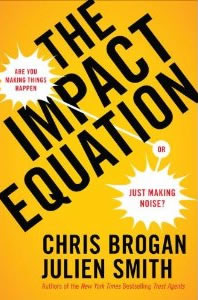By: Chuck Frey
How can you ‘shape’ your idea so it stands out compared to everything else that’s competing for people’s attention, is persuasive and easy to support and share? The authors of a new book, The Impact Equation, share one effective approach.
Chris Brogan and Julien Smith, in their new book, The Impact Equation: Are You Making Things Happen or Just Making Noise?, asks us to consider an aspect of creativity that doesn’t get much attention. But it is critically important in a business world that is increasingly focused on innovation and change, and in which we’re not always able to be face to face with the people whom we’re trying to influence with our ideas. That concept is “shaping” an idea so it is persuasive and easy to support and share.
So what is an idea’s “shape?” The authors explain this concept by way of a metaphor:
“The best idea spreaders think hard about how they design and shape their best ideas. Consider a baseball game, where the ball is round and the mitt is designed to catch it. Now change the shape of the ball but not the mitt – what happens? Both the throw and the catch become less effective. The idea is caught less often than before. Only the smartest people catch badly designed ideas – and even then, only if they have the patience to do so.”
The best ideas are usually those that are easy for the mind to take hold of, easy to understand, and easy to act upon. Think of Nike’s immensely popular tagline, “Just do it!” Like a hardy organism, a well-crafted idea is ideally suited to the ecosystem within which it must compete for survival.
The survival (and propagation) of the fittest
Brogan and Smith aren’t just talking about persuasion – getting a highly targeted group of potential buyers to invest in our ideas – but also crafting ideas so they are easy to share and propagate. Using our baseball metaphor, it means designing our ideas so they can be “connected with, to be caught and thrown again in turn.” Building ideas that people will want to support and share.
This is not a trivial consideration. Whether you’re submitting an idea to your corporate idea management system or trying to launch a new service, blog or e-book, the problem is the same: Attention is scarce, and your idea is competing with many others, also demanding attention. The bottom line is that your idea must stand out, provide unique value and be easy to share.
“The best ideators aren’t just creative; in fact, creativity is but a single aspect of idea creation. The rest is a matter of fitting the idea into its environment in an effective way – finding ways for it to spread naturally and quickly and to live beyond its initial contact with its host,” the authors explain.
The value of The Impact Equation
 Because Brogan and Smith are both bloggers, their explanation of how to cultivate ideas with impact tends to be rooted in the language of web content. But that’s OK. If you look at these concepts from a wider frame – from that of an a worker trying to influence his boss to support his Big Idea, a salesperson trying to influence a key prospective customer to buy her company’s solution or an entrpreneur seeking funding from an investor – the principles of crafting and selling ideas are the same. We win when our ideas win, and we make a bigger impact when our ideas are received, acted upon and shared.
Because Brogan and Smith are both bloggers, their explanation of how to cultivate ideas with impact tends to be rooted in the language of web content. But that’s OK. If you look at these concepts from a wider frame – from that of an a worker trying to influence his boss to support his Big Idea, a salesperson trying to influence a key prospective customer to buy her company’s solution or an entrpreneur seeking funding from an investor – the principles of crafting and selling ideas are the same. We win when our ideas win, and we make a bigger impact when our ideas are received, acted upon and shared.
What makes The Impact Equation really unique is that it is not a formulaic, 10-step explanation of technique, but rather an easy to digest, engaging discussion of strategies you can employ to make your ideas more saleable, in any environment in which you work and compete. In that sense, it’s definitely a worthwhile read.
These fascinating stories raise several questions:
- Can you or your organization use toys to spur innovation?
- Can you create something that will help kids to learn about science, technology and creativity?
- If necessity is the “mother of invention,” then the necessity of creating solutions for healthcare and energy is upon us, what solutions can you create with components like Legos?
